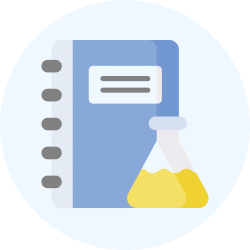NCERT Solutions for Class 7 Science - Wastewater Story
Q1: Fill in the blanks:
(a) Cleaning of water is a process of removing _______
Ans: Contaminants
 View Answer
View Answer 
Cleaning or purifying water involves removing contaminants like harmful microorganisms, chemicals, and suspended particles which are collectively called contaminants
(b) Wastewater released by houses is called _______
Ans: Sewage
 View Answer
View Answer 
Wastewater released from households, including used water from bathrooms, kitchens, and toilets, is collectively called sewage. It contains a mixture of water, human waste, and other domestic waste.
(c) Dried _______ is used as manure.
Ans: Sludge
 View Answer
View Answer 
Sludge is the solid byproduct that remains after wastewater treatment. After drying and processing, it is used as a natural fertilizer or manure because it contains nutrients that are beneficial for plants.
(d) Drains get blocked by _______ and _______
Ans: Cooking oil and fats
 View Answer
View Answer 
Cooking oil and fats, when disposed of down the drain, solidify as they cool and accumulate, leading to blockages in pipes and drains. These substances do not break down easily in water, causing clogs and hindering proper drainage.
Q2: What is sewage? Explain why it is harmful to discharge untreated sewage into rivers or seas.
Ans: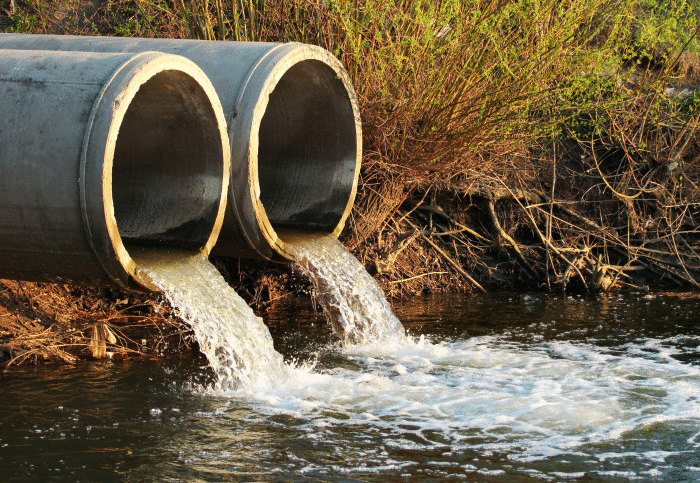 Sewage being drained into a river
Sewage being drained into a river
Ans: Sewage refers to the wastewater generated by households. It contains various pollutants and harmful microorganisms that can contaminate water. For this reason, it is crucial not to discharge untreated sewage into rivers or seas. Discharging untreated sewage is harmful because:
- It introduces disease-causing agent into the water, which can spread diseases among people.
- It can lead to the contamination of drinking water sources.
- It disrupts the ecosystem by harming aquatic life.
Q3: Why should oils and fats be not released in the drain? Explain.
Ans: Oils and fats should not be released in the drain because drains get blocked by cooking oil and fats.
Q4: Describe the steps involved in getting clarified water from wastewater.
Ans: The following steps are involved in clarifying wastewater:
- Filtration and sedimentation remove insoluble waste.
- Aeration promotes bacterial growth, breaking down human waste.
- Chlorination eliminates germs, making the water safe for consumption.
Q5: What is sludge? Explain how it is treated.
Ans: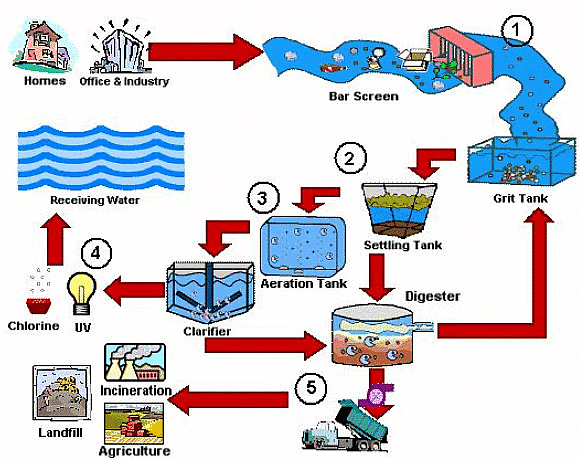 Sludge is a semi-solid slurry that can be produced from a range of industrial processes, from water treatment, wastewater treatment or on-site sanitation systems. Semi-solids such as faeces that settle down during wastewater treatment are called sludge.
Sludge is a semi-solid slurry that can be produced from a range of industrial processes, from water treatment, wastewater treatment or on-site sanitation systems. Semi-solids such as faeces that settle down during wastewater treatment are called sludge.
- This sludge is removed using a scraper and then transferred to a tank where it is decomposed by anaerobic bacteria to produce biogas. This biogas is used as a low-cost fuel for heating, cooking, etc. It is also used to produce electricity.
- Dried Sludge is used as manure instead of taking up space in a landfill or other disposal facility to improve and maintain productive soils and stimulate plant growth because it has nutrient-rich organic materials.
Q6: Untreated human excreta is a health hazard. Explain.
Ans: 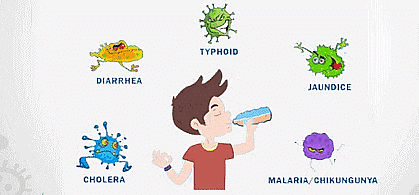 Untreated human excreta poses a significant health hazard. When human waste is not treated, it contains harmful germs that can cause serious illnesses such as cholera, diarrhoea, jaundice, and typhoid. These germs can easily spread to people through insects or contaminated food and water. Therefore, failing to treat human waste is not only a health risk but also dangerous for the entire community.
Untreated human excreta poses a significant health hazard. When human waste is not treated, it contains harmful germs that can cause serious illnesses such as cholera, diarrhoea, jaundice, and typhoid. These germs can easily spread to people through insects or contaminated food and water. Therefore, failing to treat human waste is not only a health risk but also dangerous for the entire community.
Q7: Name two chemicals used to disinfect water.
Ans: Ozone and chlorine tablets are two commonly used chemicals to disinfect water. These substances are effective in killing harmful bacteria and pathogens, ensuring that the water is safe for consumption. 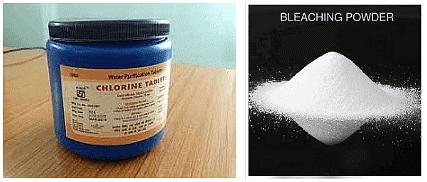
Q8: Explain the function of bar screens in a wastewater treatment plant.
Ans: Bar screens are large filters that are placed in the form of vertical screens. Large solid wastes like sticks, pebbles, sand, cans, plastic bottles, plastic bags, etc. are filtered out when the wastewater moves through the bar screen.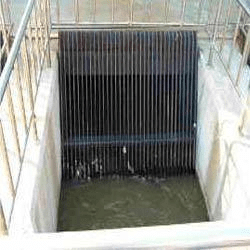 Bar Screens
Bar Screens
Q9: Explain the relationship between sanitation and disease.
Ans: Sanitation and disease are closely related. A lack of sanitation leads to unhygienic conditions, which can create many communicable diseases. Proper maintenance of sanitation significantly reduces the risk of such diseases.
Q10: Outline your role as an active citizen in relation to sanitation.
Ans: As an active citizen, my role in maintaining sanitation in both the neighbourhood and public places includes several important steps:
- Dispose of waste responsibly in designated bins.
- Separate recyclables from regular waste.
- Participate in local clean-up drives.
- Spread awareness about proper waste disposal.
- Report any sanitation issues to local authorities.
- Ensure timely resolution of problems, such as garbage accumulation or blocked drains.
- Use water efficiently to prevent wastage.
- Encourage the community to adopt water-saving practices.
- Follow personal hygiene habits to prevent the spread of diseases.
- Engage with the community in discussions on sanitation.
Q11: Here is a crossword puzzle. 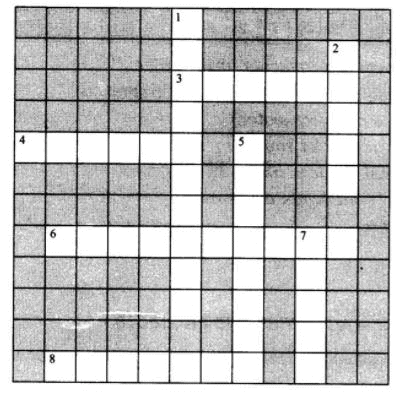
Across
3. Liquid waste products
4. Solid waste extracted in sewage treatment
6. A word related to hygiene
8. Waste matter discharged from the human body
Down
1. Used water
2. A pipe carrying sewage
5. Micro-organisms which cause cholera
7. A chemical to disinfect water
Ans:
Across
3. Sewage
4. Sludge
6. Sanitation
4. Excreta
Down
1. Wastewater
2. Sewer
5. Bacteria
7. Ozone
Q12: Study the following statements about ozone:
(a) It is essential for the breathing of living organisms
(b) It is used to disinfect water
(c) It absorbs ultraviolet rays
(d) Its proportion in air is about 3%
Which of these statements are correct?
(i) (a), (b) and (c)
(ii) (b) and (c)
(iii) (a) and (d)
(iv) All four
Ans: (ii) b and c
 View Answer
View Answer 
(b) It is used to disinfect water
- Correct: Ozone is used in some water treatment processes as a disinfectant. It can effectively kill bacteria, viruses, and other pathogens in water, making it safe for consumption.
(c) It absorbs ultraviolet rays
- Correct: Ozone in the stratosphere absorbs the majority of the sun's harmful ultraviolet (UV) radiation. This helps protect living organisms on Earth from UV-induced damage.
|
112 videos|286 docs|28 tests
|
FAQs on NCERT Solutions for Class 7 Science - Wastewater Story
| 1. What is wastewater, and why is it important to manage it properly? |  |
| 2. What are the main sources of wastewater? |  |
| 3. What are the common methods used for treating wastewater? |  |
| 4. How does untreated wastewater affect the environment? |  |
| 5. What role do individuals play in wastewater management? |  |




